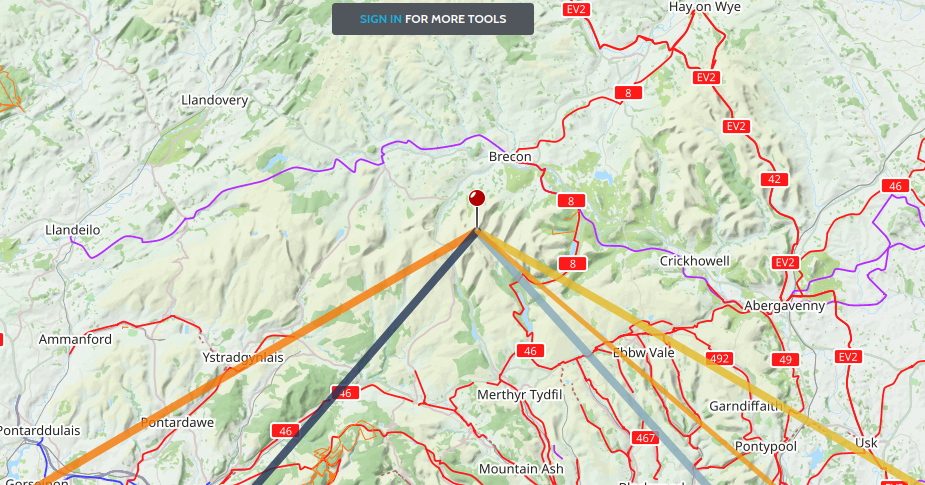Time, direction, and location
These colours are characteristic of the time around sunrise and sunset, facing towards the sun. So first you have to consider when, and at what angle, the sun will rise or set. A site like timeanddate.com (link is to my city) will calculate both the time and the bearing.
Obviously for sunrise you want a clear view to the east(ish), and for sunset, to the west(ish). Both of these are much closer to the equator in winter, and to the poles in summer, so your sunrise direction varies with the season - from NNE in summer to SSE in winter, for northern mid latitudes. Winter can give better shots in many locations, because of the lower humidity - unless a hazy effect is what you're looking for.
Sunrise often has clearer skies, as the temperature, humidity (affecting cloud cover) and level of pollution drop overnight. Some mountainous regions get afternoon thunderstorms and the clouds from those don't dissipate fast. On the other hand, you can look at the sky an hour or so before sunset and have an idea what the conditions will be like; for sunrise, you'll need to look at the forecast the night before, or get up very early.
During the day, you can scout a location's views in that direction at that time, to make sure there's nothing annoying in shot. Google Street View is useful not just for locations you can drive to, but also for popular viewpoints. So if you can't scout the location yourself, that may help.
Then aim to get there half an hour before sunset or an hour before sunrise. The best colours are usually when the sun is below the horizon. And don't forget that from high ground (with respect to the sunward terrain) the horizon is lower, making the sun appear higher.
Weather
Obviously you don't want heavy cloud. Broken or scattered cloud adds interest to the shot compared to clear skies (in your second example the clouds are lit from blow by the sun passing through a thick layer of atmosphere). For the latter you probably want an interesting horizon line and for the sun to be well below it (as in your first example).
You should look at the weather forecast for somewhere around 50km east of your viewpoint at sunrise, the same distance west at sunset, in addition to where you'll be. This should be similar, but in mountainous terrain often isn't.
The weather can change fast though, as you'll see from the example I give below.
Other features
A crescent moon (you won't get a full moon as that's opposite the sun in the sky) or a planet (Venus is the brightest star-like point of light in the sky) can add interest, Various tools can tell you what will be visible where and when. Sky Map for Android is what I use as it's free and simple. The location doesn't matter much within an hour's drive, but the time is important.
Examples
It's not my most colourful sunrise/set shot, but I have it here, well enough located in space and time to use it.

I shot this panorama at approximately (I don't have the metadata here, but the hike is on Strava) 0725 on 15 November 2021, at Pen y Fan. The hike up was in drizzle and light rain, but the cloud lifted just in time. There was even a rainbow but it didn't make the panorama. Timeanddate.com tells me that the sun rose at 0733 on a bearing of 120° (near enough ESE) - a few minutes after this shot, but it's above the apparent horizon. It's pretty much horizontal in the shot, so I was holding the camera pretty much horizontal There's a lake visible in the distance, the southern tip of which is on 72°. The best colours reach about half way to that from the sun, so around 45--50°. That means that - in this case - you need to consider the view from ENE to SSE. And for your purposes although this is the highest peak in the area, it might not be the best choice because Cribyn and Waun Rydd aren't that much lower and are sunwards.
With the sun above the hills, I'm getting some lens flare in this shot. For colours, shooting before the sun came over the other hills would have been better.
A lot of this is rather nicely automated by The Photographer's Ephemeris - this screenshot shows a few features for the location and date of my example shot.

This is a sunset, over the Nicoya Peninsula in Costa Rica, January 2011 (Wikipedia, where there's a full-resolution version of my photo). The colours are as shot, but I used high dynamic range (HDR) techniques to get detail in both the foreground and the sky - the beach ans bushes were pretty dark, not surprisingly as it was about an hour after the nominal time of sunset. I was facing almost due west. Sunsets shot in the mountains a couple of days earlier, at a very similar time of day were considerably darker and redder, so timing is important.

One final set of examples. These were shot on Kodachrome 64 slide film in February 1994, from the top of Mount Sinai at sunrise, and scanned several years later - so I don't have metadata. I used a rock for a tripod, and when I started the sequence of 10 images it was too dark to focus. By the third of the images I selected here, when the sun was starting to show, the colours were washing out. That's nominal sunrise, about 06:20, with the middle image 20-30 minutes before that, and the left one another 10-20 minutes before that. So start setting up around an hour before sunrise by torchlight, then relax and let your eyes adjust.




